Financial Aspects for Marketing, Events & Tourism: Investment Analysis
VerifiedAdded on 2022/07/21
|8
|2022
|21
Report
AI Summary
This report provides a detailed investment appraisal analysis for Aspect Ltd, evaluating the financial viability of a potential investment using several key methods. The analysis includes the calculation and interpretation of the payback period, accounting rate of return (ARR), net present value (NPV), and internal rate of return (IRR). The report assesses each method's strengths and weaknesses, providing a comprehensive understanding of the investment's potential. The payback period is calculated to determine the time required to recover the initial investment, while ARR assesses the average profitability. NPV and IRR are used to evaluate the project's profitability considering the time value of money. The report concludes with a recommendation based on the findings, suggesting whether Aspect Ltd should proceed with the investment. The analysis highlights the importance of considering both short-term and long-term financial implications, providing valuable insights for informed decision-making.
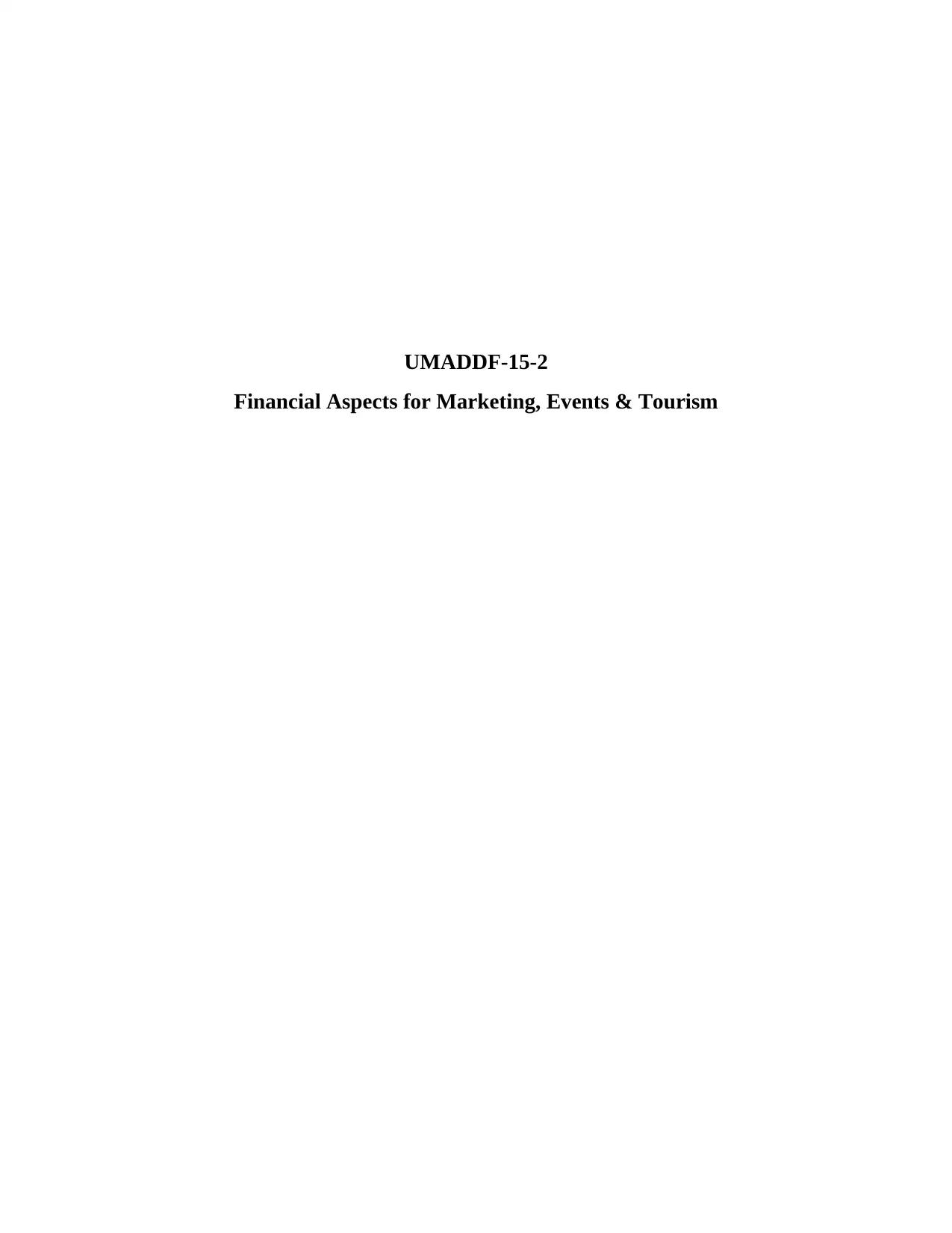
UMADDF-15-2
Financial Aspects for Marketing, Events & Tourism
Financial Aspects for Marketing, Events & Tourism
Paraphrase This Document
Need a fresh take? Get an instant paraphrase of this document with our AI Paraphraser
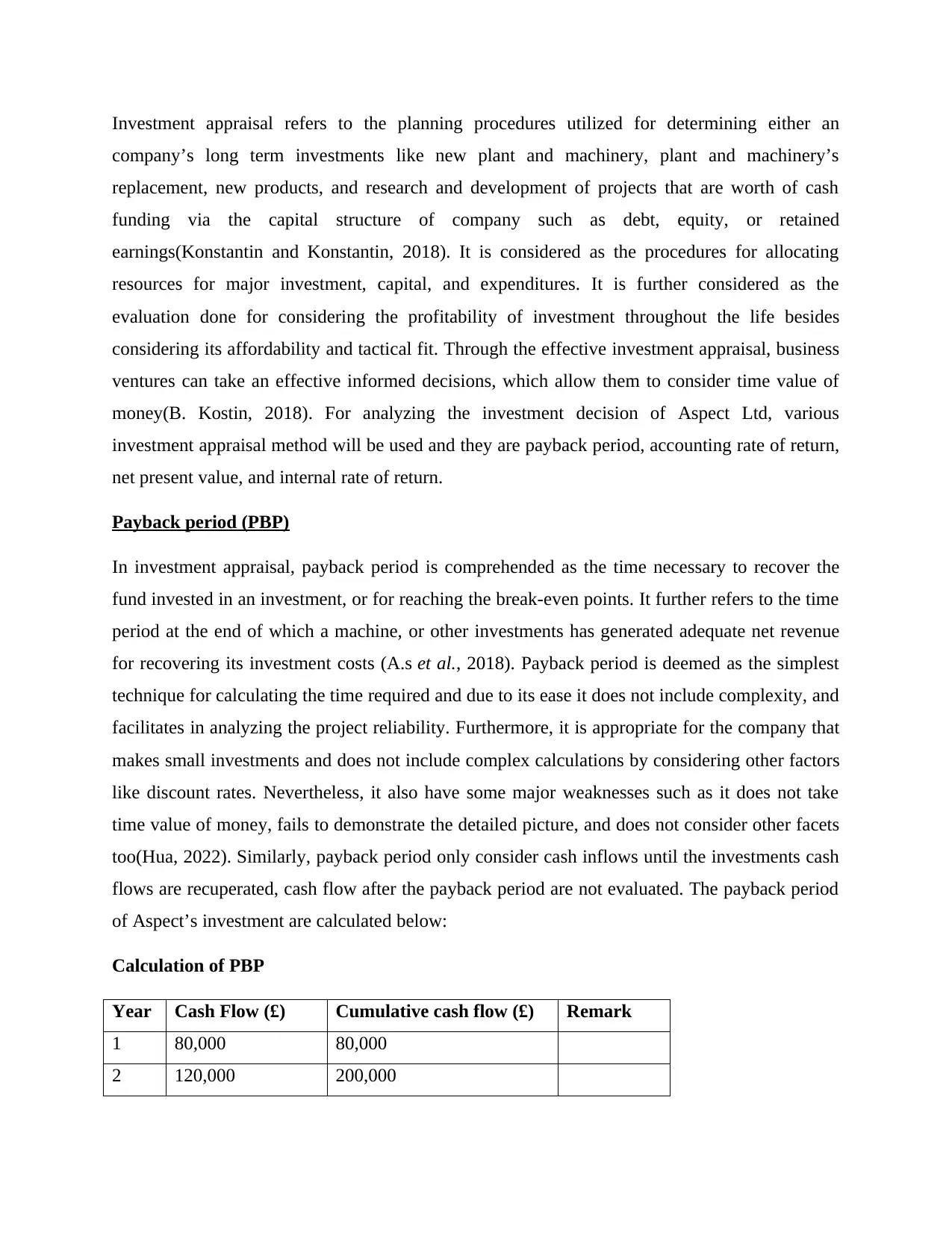
Investment appraisal refers to the planning procedures utilized for determining either an
company’s long term investments like new plant and machinery, plant and machinery’s
replacement, new products, and research and development of projects that are worth of cash
funding via the capital structure of company such as debt, equity, or retained
earnings(Konstantin and Konstantin, 2018). It is considered as the procedures for allocating
resources for major investment, capital, and expenditures. It is further considered as the
evaluation done for considering the profitability of investment throughout the life besides
considering its affordability and tactical fit. Through the effective investment appraisal, business
ventures can take an effective informed decisions, which allow them to consider time value of
money(B. Kostin, 2018). For analyzing the investment decision of Aspect Ltd, various
investment appraisal method will be used and they are payback period, accounting rate of return,
net present value, and internal rate of return.
Payback period (PBP)
In investment appraisal, payback period is comprehended as the time necessary to recover the
fund invested in an investment, or for reaching the break-even points. It further refers to the time
period at the end of which a machine, or other investments has generated adequate net revenue
for recovering its investment costs (A.s et al., 2018). Payback period is deemed as the simplest
technique for calculating the time required and due to its ease it does not include complexity, and
facilitates in analyzing the project reliability. Furthermore, it is appropriate for the company that
makes small investments and does not include complex calculations by considering other factors
like discount rates. Nevertheless, it also have some major weaknesses such as it does not take
time value of money, fails to demonstrate the detailed picture, and does not consider other facets
too(Hua, 2022). Similarly, payback period only consider cash inflows until the investments cash
flows are recuperated, cash flow after the payback period are not evaluated. The payback period
of Aspect’s investment are calculated below:
Calculation of PBP
Year Cash Flow (£) Cumulative cash flow (£) Remark
1 80,000 80,000
2 120,000 200,000
company’s long term investments like new plant and machinery, plant and machinery’s
replacement, new products, and research and development of projects that are worth of cash
funding via the capital structure of company such as debt, equity, or retained
earnings(Konstantin and Konstantin, 2018). It is considered as the procedures for allocating
resources for major investment, capital, and expenditures. It is further considered as the
evaluation done for considering the profitability of investment throughout the life besides
considering its affordability and tactical fit. Through the effective investment appraisal, business
ventures can take an effective informed decisions, which allow them to consider time value of
money(B. Kostin, 2018). For analyzing the investment decision of Aspect Ltd, various
investment appraisal method will be used and they are payback period, accounting rate of return,
net present value, and internal rate of return.
Payback period (PBP)
In investment appraisal, payback period is comprehended as the time necessary to recover the
fund invested in an investment, or for reaching the break-even points. It further refers to the time
period at the end of which a machine, or other investments has generated adequate net revenue
for recovering its investment costs (A.s et al., 2018). Payback period is deemed as the simplest
technique for calculating the time required and due to its ease it does not include complexity, and
facilitates in analyzing the project reliability. Furthermore, it is appropriate for the company that
makes small investments and does not include complex calculations by considering other factors
like discount rates. Nevertheless, it also have some major weaknesses such as it does not take
time value of money, fails to demonstrate the detailed picture, and does not consider other facets
too(Hua, 2022). Similarly, payback period only consider cash inflows until the investments cash
flows are recuperated, cash flow after the payback period are not evaluated. The payback period
of Aspect’s investment are calculated below:
Calculation of PBP
Year Cash Flow (£) Cumulative cash flow (£) Remark
1 80,000 80,000
2 120,000 200,000
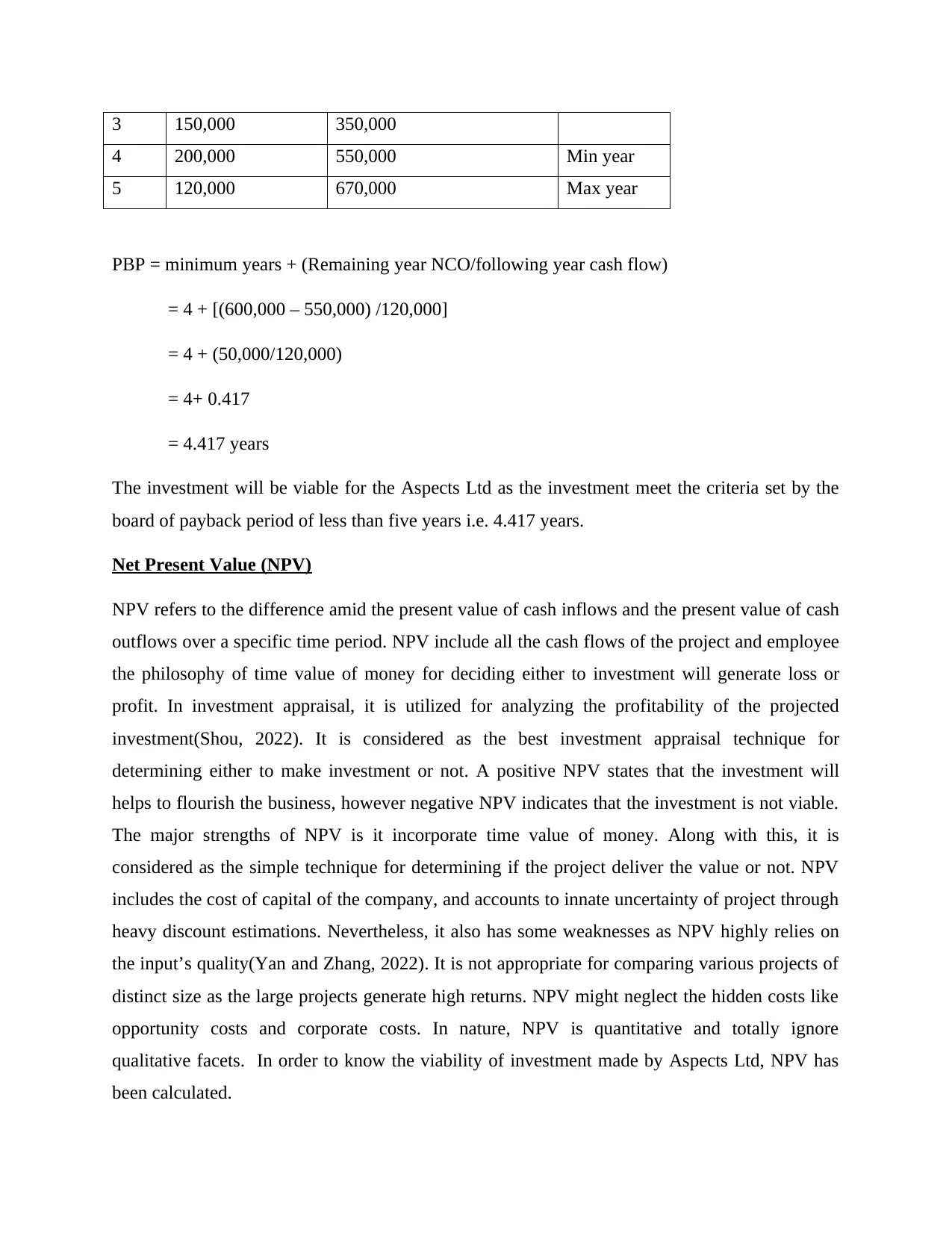
3 150,000 350,000
4 200,000 550,000 Min year
5 120,000 670,000 Max year
PBP = minimum years + (Remaining year NCO/following year cash flow)
= 4 + [(600,000 – 550,000) /120,000]
= 4 + (50,000/120,000)
= 4+ 0.417
= 4.417 years
The investment will be viable for the Aspects Ltd as the investment meet the criteria set by the
board of payback period of less than five years i.e. 4.417 years.
Net Present Value (NPV)
NPV refers to the difference amid the present value of cash inflows and the present value of cash
outflows over a specific time period. NPV include all the cash flows of the project and employee
the philosophy of time value of money for deciding either to investment will generate loss or
profit. In investment appraisal, it is utilized for analyzing the profitability of the projected
investment(Shou, 2022). It is considered as the best investment appraisal technique for
determining either to make investment or not. A positive NPV states that the investment will
helps to flourish the business, however negative NPV indicates that the investment is not viable.
The major strengths of NPV is it incorporate time value of money. Along with this, it is
considered as the simple technique for determining if the project deliver the value or not. NPV
includes the cost of capital of the company, and accounts to innate uncertainty of project through
heavy discount estimations. Nevertheless, it also has some weaknesses as NPV highly relies on
the input’s quality(Yan and Zhang, 2022). It is not appropriate for comparing various projects of
distinct size as the large projects generate high returns. NPV might neglect the hidden costs like
opportunity costs and corporate costs. In nature, NPV is quantitative and totally ignore
qualitative facets. In order to know the viability of investment made by Aspects Ltd, NPV has
been calculated.
4 200,000 550,000 Min year
5 120,000 670,000 Max year
PBP = minimum years + (Remaining year NCO/following year cash flow)
= 4 + [(600,000 – 550,000) /120,000]
= 4 + (50,000/120,000)
= 4+ 0.417
= 4.417 years
The investment will be viable for the Aspects Ltd as the investment meet the criteria set by the
board of payback period of less than five years i.e. 4.417 years.
Net Present Value (NPV)
NPV refers to the difference amid the present value of cash inflows and the present value of cash
outflows over a specific time period. NPV include all the cash flows of the project and employee
the philosophy of time value of money for deciding either to investment will generate loss or
profit. In investment appraisal, it is utilized for analyzing the profitability of the projected
investment(Shou, 2022). It is considered as the best investment appraisal technique for
determining either to make investment or not. A positive NPV states that the investment will
helps to flourish the business, however negative NPV indicates that the investment is not viable.
The major strengths of NPV is it incorporate time value of money. Along with this, it is
considered as the simple technique for determining if the project deliver the value or not. NPV
includes the cost of capital of the company, and accounts to innate uncertainty of project through
heavy discount estimations. Nevertheless, it also has some weaknesses as NPV highly relies on
the input’s quality(Yan and Zhang, 2022). It is not appropriate for comparing various projects of
distinct size as the large projects generate high returns. NPV might neglect the hidden costs like
opportunity costs and corporate costs. In nature, NPV is quantitative and totally ignore
qualitative facets. In order to know the viability of investment made by Aspects Ltd, NPV has
been calculated.
⊘ This is a preview!⊘
Do you want full access?
Subscribe today to unlock all pages.

Trusted by 1+ million students worldwide
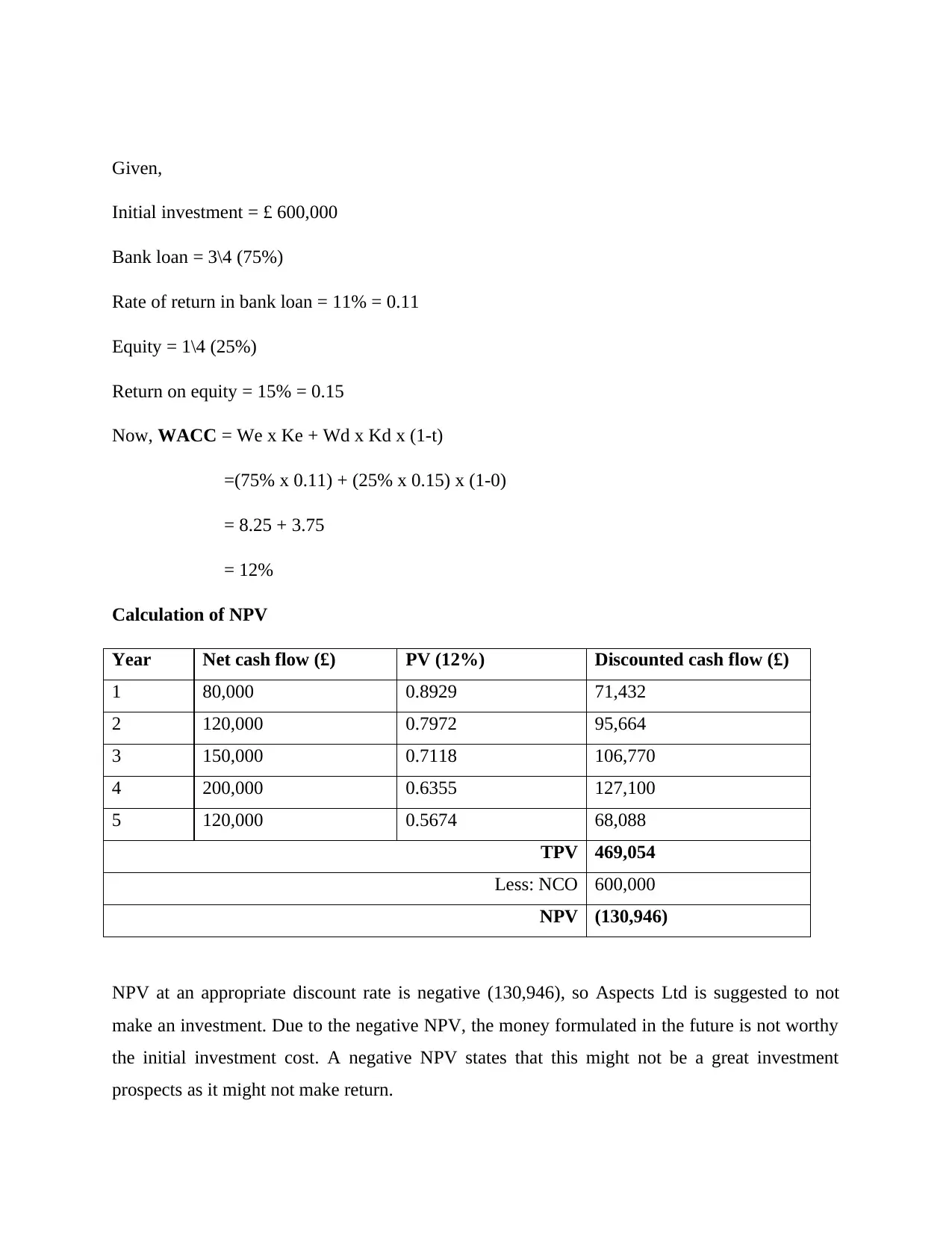
Given,
Initial investment = £ 600,000
Bank loan = 3\4 (75%)
Rate of return in bank loan = 11% = 0.11
Equity = 1\4 (25%)
Return on equity = 15% = 0.15
Now, WACC = We x Ke + Wd x Kd x (1-t)
=(75% x 0.11) + (25% x 0.15) x (1-0)
= 8.25 + 3.75
= 12%
Calculation of NPV
Year Net cash flow (£) PV (12%) Discounted cash flow (£)
1 80,000 0.8929 71,432
2 120,000 0.7972 95,664
3 150,000 0.7118 106,770
4 200,000 0.6355 127,100
5 120,000 0.5674 68,088
TPV 469,054
Less: NCO 600,000
NPV (130,946)
NPV at an appropriate discount rate is negative (130,946), so Aspects Ltd is suggested to not
make an investment. Due to the negative NPV, the money formulated in the future is not worthy
the initial investment cost. A negative NPV states that this might not be a great investment
prospects as it might not make return.
Initial investment = £ 600,000
Bank loan = 3\4 (75%)
Rate of return in bank loan = 11% = 0.11
Equity = 1\4 (25%)
Return on equity = 15% = 0.15
Now, WACC = We x Ke + Wd x Kd x (1-t)
=(75% x 0.11) + (25% x 0.15) x (1-0)
= 8.25 + 3.75
= 12%
Calculation of NPV
Year Net cash flow (£) PV (12%) Discounted cash flow (£)
1 80,000 0.8929 71,432
2 120,000 0.7972 95,664
3 150,000 0.7118 106,770
4 200,000 0.6355 127,100
5 120,000 0.5674 68,088
TPV 469,054
Less: NCO 600,000
NPV (130,946)
NPV at an appropriate discount rate is negative (130,946), so Aspects Ltd is suggested to not
make an investment. Due to the negative NPV, the money formulated in the future is not worthy
the initial investment cost. A negative NPV states that this might not be a great investment
prospects as it might not make return.
Paraphrase This Document
Need a fresh take? Get an instant paraphrase of this document with our AI Paraphraser
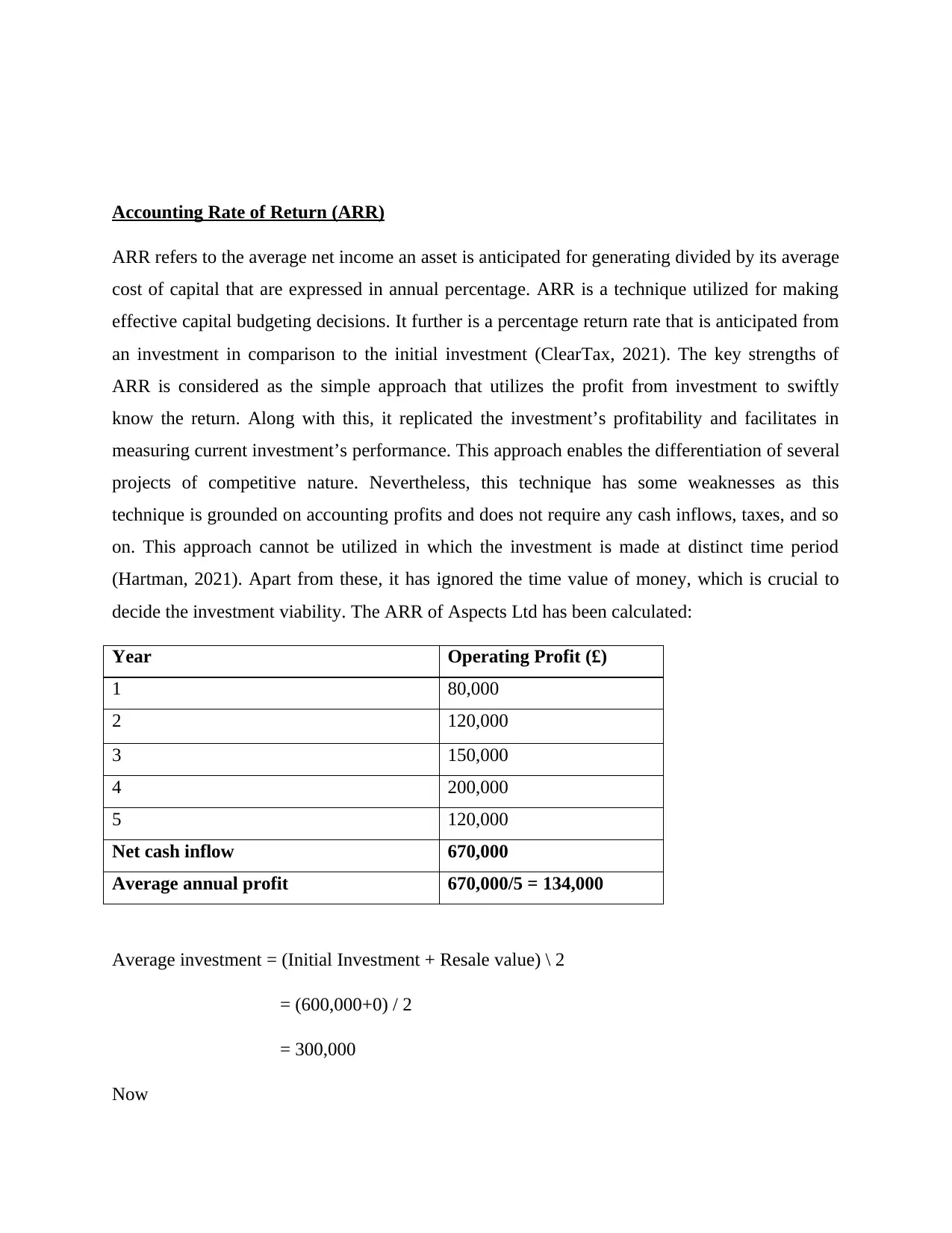
Accounting Rate of Return (ARR)
ARR refers to the average net income an asset is anticipated for generating divided by its average
cost of capital that are expressed in annual percentage. ARR is a technique utilized for making
effective capital budgeting decisions. It further is a percentage return rate that is anticipated from
an investment in comparison to the initial investment (ClearTax, 2021). The key strengths of
ARR is considered as the simple approach that utilizes the profit from investment to swiftly
know the return. Along with this, it replicated the investment’s profitability and facilitates in
measuring current investment’s performance. This approach enables the differentiation of several
projects of competitive nature. Nevertheless, this technique has some weaknesses as this
technique is grounded on accounting profits and does not require any cash inflows, taxes, and so
on. This approach cannot be utilized in which the investment is made at distinct time period
(Hartman, 2021). Apart from these, it has ignored the time value of money, which is crucial to
decide the investment viability. The ARR of Aspects Ltd has been calculated:
Year Operating Profit (£)
1 80,000
2 120,000
3 150,000
4 200,000
5 120,000
Net cash inflow 670,000
Average annual profit 670,000/5 = 134,000
Average investment = (Initial Investment + Resale value) \ 2
= (600,000+0) / 2
= 300,000
Now
ARR refers to the average net income an asset is anticipated for generating divided by its average
cost of capital that are expressed in annual percentage. ARR is a technique utilized for making
effective capital budgeting decisions. It further is a percentage return rate that is anticipated from
an investment in comparison to the initial investment (ClearTax, 2021). The key strengths of
ARR is considered as the simple approach that utilizes the profit from investment to swiftly
know the return. Along with this, it replicated the investment’s profitability and facilitates in
measuring current investment’s performance. This approach enables the differentiation of several
projects of competitive nature. Nevertheless, this technique has some weaknesses as this
technique is grounded on accounting profits and does not require any cash inflows, taxes, and so
on. This approach cannot be utilized in which the investment is made at distinct time period
(Hartman, 2021). Apart from these, it has ignored the time value of money, which is crucial to
decide the investment viability. The ARR of Aspects Ltd has been calculated:
Year Operating Profit (£)
1 80,000
2 120,000
3 150,000
4 200,000
5 120,000
Net cash inflow 670,000
Average annual profit 670,000/5 = 134,000
Average investment = (Initial Investment + Resale value) \ 2
= (600,000+0) / 2
= 300,000
Now
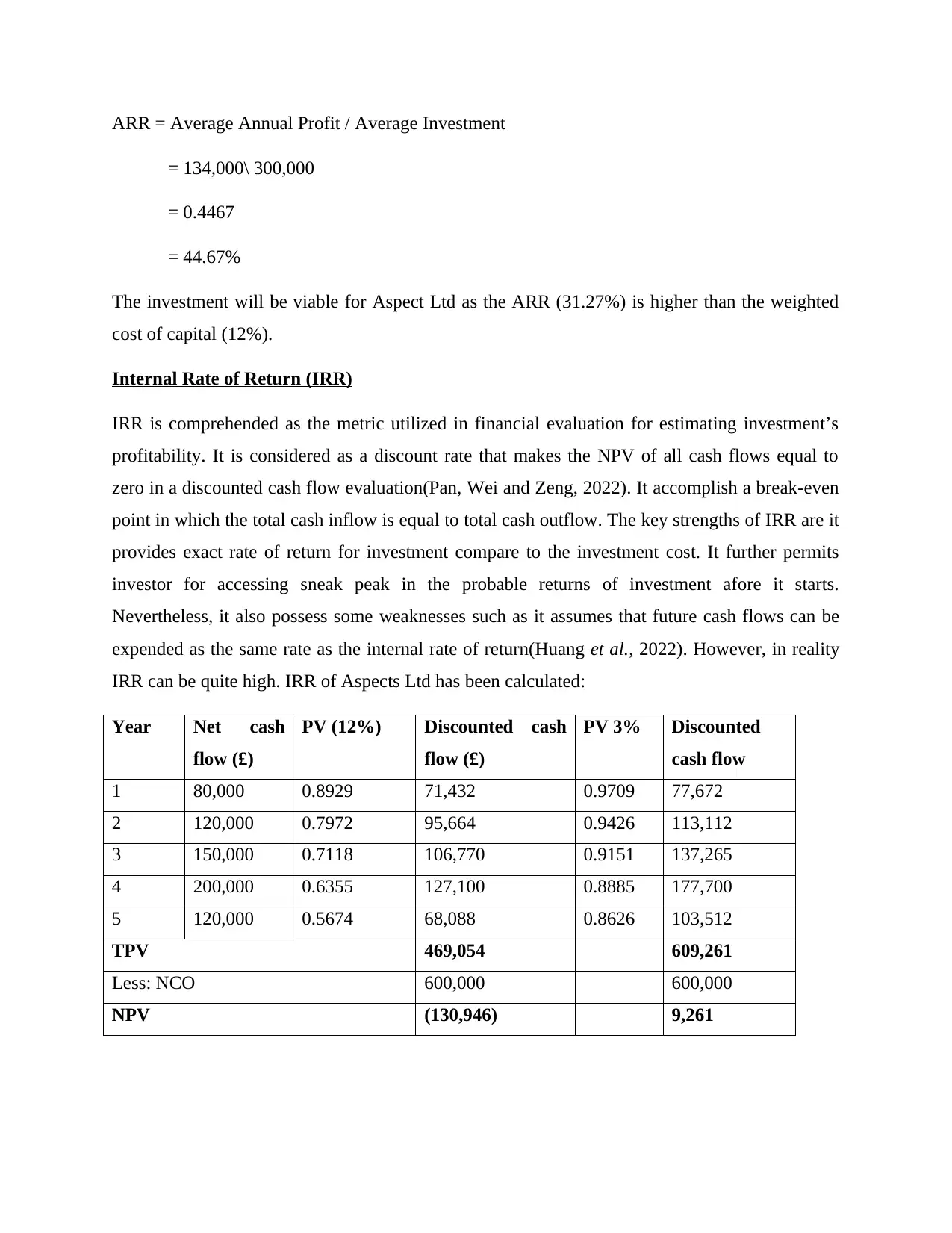
ARR = Average Annual Profit / Average Investment
= 134,000\ 300,000
= 0.4467
= 44.67%
The investment will be viable for Aspect Ltd as the ARR (31.27%) is higher than the weighted
cost of capital (12%).
Internal Rate of Return (IRR)
IRR is comprehended as the metric utilized in financial evaluation for estimating investment’s
profitability. It is considered as a discount rate that makes the NPV of all cash flows equal to
zero in a discounted cash flow evaluation(Pan, Wei and Zeng, 2022). It accomplish a break-even
point in which the total cash inflow is equal to total cash outflow. The key strengths of IRR are it
provides exact rate of return for investment compare to the investment cost. It further permits
investor for accessing sneak peak in the probable returns of investment afore it starts.
Nevertheless, it also possess some weaknesses such as it assumes that future cash flows can be
expended as the same rate as the internal rate of return(Huang et al., 2022). However, in reality
IRR can be quite high. IRR of Aspects Ltd has been calculated:
Year Net cash
flow (£)
PV (12%) Discounted cash
flow (£)
PV 3% Discounted
cash flow
1 80,000 0.8929 71,432 0.9709 77,672
2 120,000 0.7972 95,664 0.9426 113,112
3 150,000 0.7118 106,770 0.9151 137,265
4 200,000 0.6355 127,100 0.8885 177,700
5 120,000 0.5674 68,088 0.8626 103,512
TPV 469,054 609,261
Less: NCO 600,000 600,000
NPV (130,946) 9,261
= 134,000\ 300,000
= 0.4467
= 44.67%
The investment will be viable for Aspect Ltd as the ARR (31.27%) is higher than the weighted
cost of capital (12%).
Internal Rate of Return (IRR)
IRR is comprehended as the metric utilized in financial evaluation for estimating investment’s
profitability. It is considered as a discount rate that makes the NPV of all cash flows equal to
zero in a discounted cash flow evaluation(Pan, Wei and Zeng, 2022). It accomplish a break-even
point in which the total cash inflow is equal to total cash outflow. The key strengths of IRR are it
provides exact rate of return for investment compare to the investment cost. It further permits
investor for accessing sneak peak in the probable returns of investment afore it starts.
Nevertheless, it also possess some weaknesses such as it assumes that future cash flows can be
expended as the same rate as the internal rate of return(Huang et al., 2022). However, in reality
IRR can be quite high. IRR of Aspects Ltd has been calculated:
Year Net cash
flow (£)
PV (12%) Discounted cash
flow (£)
PV 3% Discounted
cash flow
1 80,000 0.8929 71,432 0.9709 77,672
2 120,000 0.7972 95,664 0.9426 113,112
3 150,000 0.7118 106,770 0.9151 137,265
4 200,000 0.6355 127,100 0.8885 177,700
5 120,000 0.5674 68,088 0.8626 103,512
TPV 469,054 609,261
Less: NCO 600,000 600,000
NPV (130,946) 9,261
⊘ This is a preview!⊘
Do you want full access?
Subscribe today to unlock all pages.

Trusted by 1+ million students worldwide
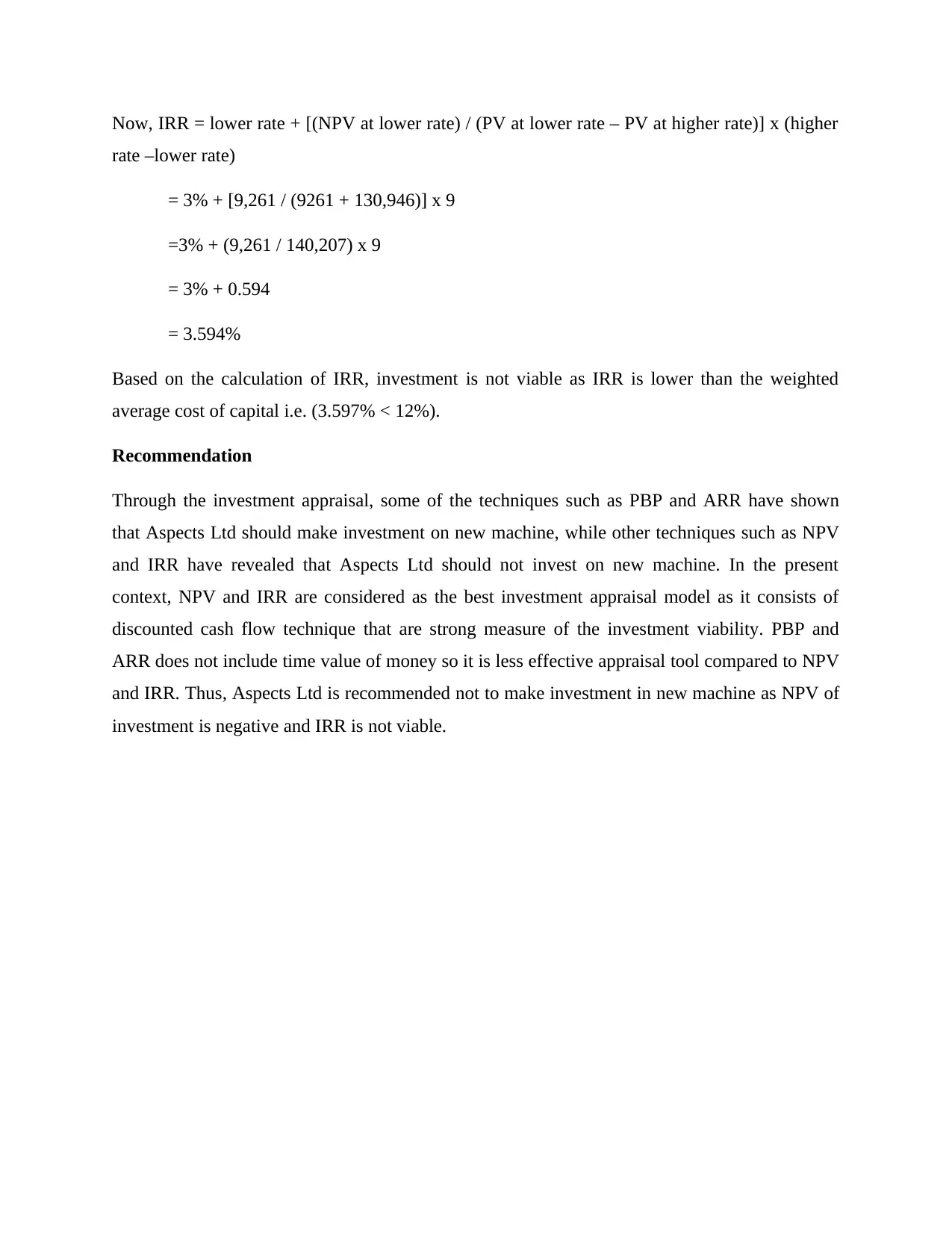
Now, IRR = lower rate + [(NPV at lower rate) / (PV at lower rate – PV at higher rate)] x (higher
rate –lower rate)
= 3% + [9,261 / (9261 + 130,946)] x 9
=3% + (9,261 / 140,207) x 9
= 3% + 0.594
= 3.594%
Based on the calculation of IRR, investment is not viable as IRR is lower than the weighted
average cost of capital i.e. (3.597% < 12%).
Recommendation
Through the investment appraisal, some of the techniques such as PBP and ARR have shown
that Aspects Ltd should make investment on new machine, while other techniques such as NPV
and IRR have revealed that Aspects Ltd should not invest on new machine. In the present
context, NPV and IRR are considered as the best investment appraisal model as it consists of
discounted cash flow technique that are strong measure of the investment viability. PBP and
ARR does not include time value of money so it is less effective appraisal tool compared to NPV
and IRR. Thus, Aspects Ltd is recommended not to make investment in new machine as NPV of
investment is negative and IRR is not viable.
rate –lower rate)
= 3% + [9,261 / (9261 + 130,946)] x 9
=3% + (9,261 / 140,207) x 9
= 3% + 0.594
= 3.594%
Based on the calculation of IRR, investment is not viable as IRR is lower than the weighted
average cost of capital i.e. (3.597% < 12%).
Recommendation
Through the investment appraisal, some of the techniques such as PBP and ARR have shown
that Aspects Ltd should make investment on new machine, while other techniques such as NPV
and IRR have revealed that Aspects Ltd should not invest on new machine. In the present
context, NPV and IRR are considered as the best investment appraisal model as it consists of
discounted cash flow technique that are strong measure of the investment viability. PBP and
ARR does not include time value of money so it is less effective appraisal tool compared to NPV
and IRR. Thus, Aspects Ltd is recommended not to make investment in new machine as NPV of
investment is negative and IRR is not viable.
Paraphrase This Document
Need a fresh take? Get an instant paraphrase of this document with our AI Paraphraser
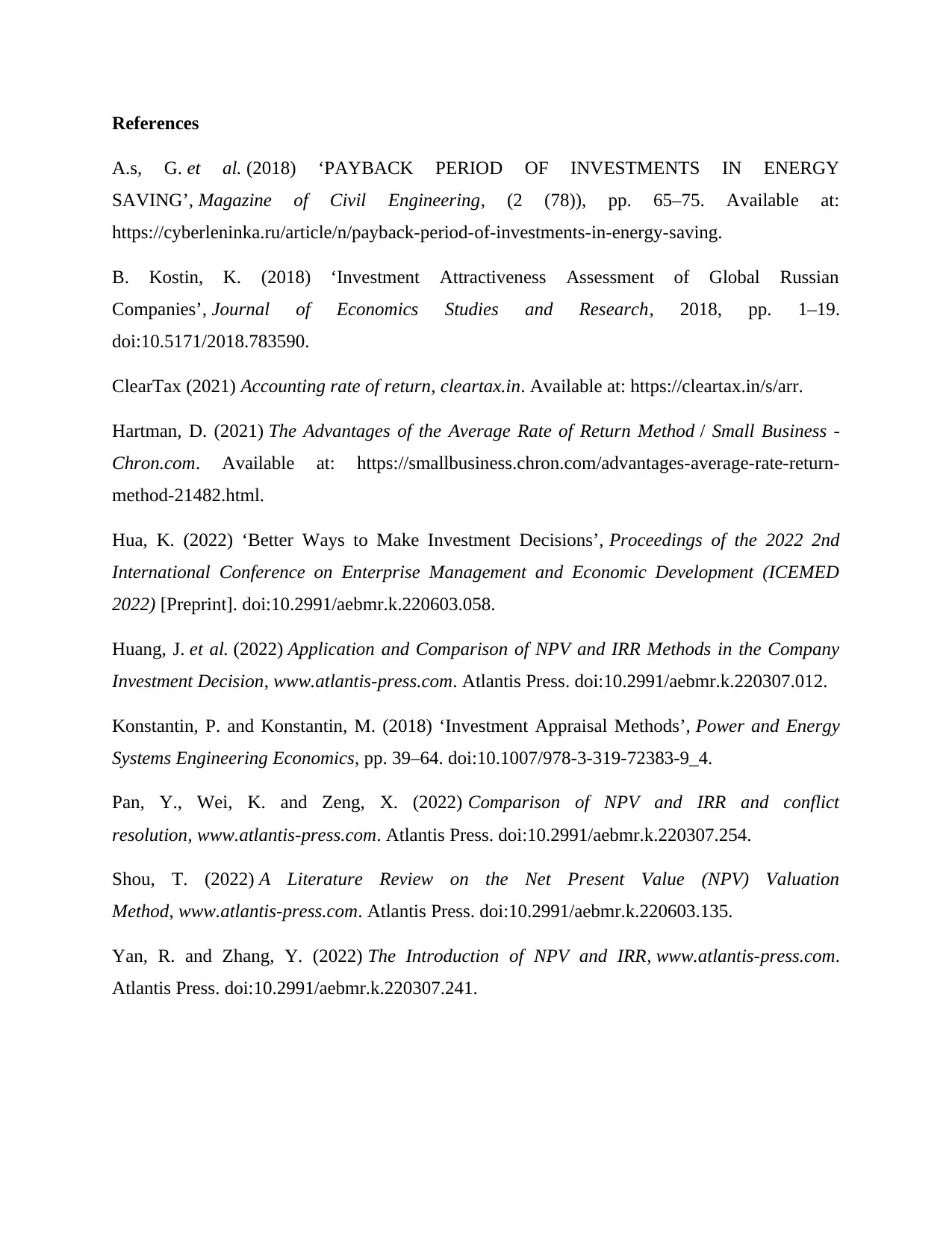
References
A.s, G. et al. (2018) ‘PAYBACK PERIOD OF INVESTMENTS IN ENERGY
SAVING’, Magazine of Civil Engineering, (2 (78)), pp. 65–75. Available at:
https://cyberleninka.ru/article/n/payback-period-of-investments-in-energy-saving.
B. Kostin, K. (2018) ‘Investment Attractiveness Assessment of Global Russian
Companies’, Journal of Economics Studies and Research, 2018, pp. 1–19.
doi:10.5171/2018.783590.
ClearTax (2021) Accounting rate of return, cleartax.in. Available at: https://cleartax.in/s/arr.
Hartman, D. (2021) The Advantages of the Average Rate of Return Method / Small Business -
Chron.com. Available at: https://smallbusiness.chron.com/advantages-average-rate-return-
method-21482.html.
Hua, K. (2022) ‘Better Ways to Make Investment Decisions’, Proceedings of the 2022 2nd
International Conference on Enterprise Management and Economic Development (ICEMED
2022) [Preprint]. doi:10.2991/aebmr.k.220603.058.
Huang, J. et al. (2022) Application and Comparison of NPV and IRR Methods in the Company
Investment Decision, www.atlantis-press.com. Atlantis Press. doi:10.2991/aebmr.k.220307.012.
Konstantin, P. and Konstantin, M. (2018) ‘Investment Appraisal Methods’, Power and Energy
Systems Engineering Economics, pp. 39–64. doi:10.1007/978-3-319-72383-9_4.
Pan, Y., Wei, K. and Zeng, X. (2022) Comparison of NPV and IRR and conflict
resolution, www.atlantis-press.com. Atlantis Press. doi:10.2991/aebmr.k.220307.254.
Shou, T. (2022) A Literature Review on the Net Present Value (NPV) Valuation
Method, www.atlantis-press.com. Atlantis Press. doi:10.2991/aebmr.k.220603.135.
Yan, R. and Zhang, Y. (2022) The Introduction of NPV and IRR, www.atlantis-press.com.
Atlantis Press. doi:10.2991/aebmr.k.220307.241.
A.s, G. et al. (2018) ‘PAYBACK PERIOD OF INVESTMENTS IN ENERGY
SAVING’, Magazine of Civil Engineering, (2 (78)), pp. 65–75. Available at:
https://cyberleninka.ru/article/n/payback-period-of-investments-in-energy-saving.
B. Kostin, K. (2018) ‘Investment Attractiveness Assessment of Global Russian
Companies’, Journal of Economics Studies and Research, 2018, pp. 1–19.
doi:10.5171/2018.783590.
ClearTax (2021) Accounting rate of return, cleartax.in. Available at: https://cleartax.in/s/arr.
Hartman, D. (2021) The Advantages of the Average Rate of Return Method / Small Business -
Chron.com. Available at: https://smallbusiness.chron.com/advantages-average-rate-return-
method-21482.html.
Hua, K. (2022) ‘Better Ways to Make Investment Decisions’, Proceedings of the 2022 2nd
International Conference on Enterprise Management and Economic Development (ICEMED
2022) [Preprint]. doi:10.2991/aebmr.k.220603.058.
Huang, J. et al. (2022) Application and Comparison of NPV and IRR Methods in the Company
Investment Decision, www.atlantis-press.com. Atlantis Press. doi:10.2991/aebmr.k.220307.012.
Konstantin, P. and Konstantin, M. (2018) ‘Investment Appraisal Methods’, Power and Energy
Systems Engineering Economics, pp. 39–64. doi:10.1007/978-3-319-72383-9_4.
Pan, Y., Wei, K. and Zeng, X. (2022) Comparison of NPV and IRR and conflict
resolution, www.atlantis-press.com. Atlantis Press. doi:10.2991/aebmr.k.220307.254.
Shou, T. (2022) A Literature Review on the Net Present Value (NPV) Valuation
Method, www.atlantis-press.com. Atlantis Press. doi:10.2991/aebmr.k.220603.135.
Yan, R. and Zhang, Y. (2022) The Introduction of NPV and IRR, www.atlantis-press.com.
Atlantis Press. doi:10.2991/aebmr.k.220307.241.
1 out of 8
Related Documents
Your All-in-One AI-Powered Toolkit for Academic Success.
+13062052269
info@desklib.com
Available 24*7 on WhatsApp / Email
![[object Object]](/_next/static/media/star-bottom.7253800d.svg)
Unlock your academic potential
Copyright © 2020–2025 A2Z Services. All Rights Reserved. Developed and managed by ZUCOL.




